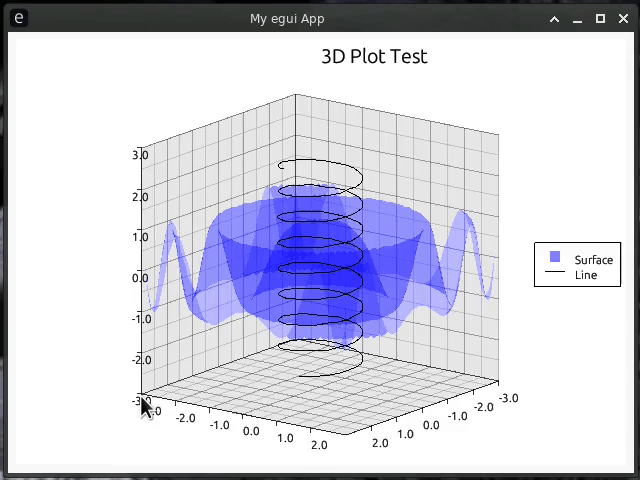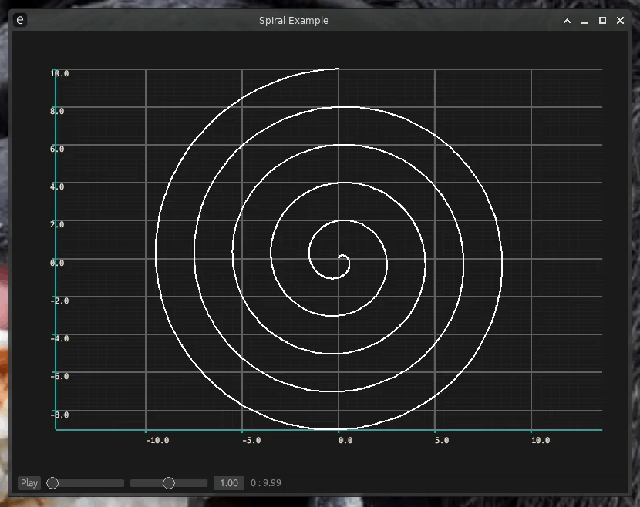egui-plotter



simple to use utilties for integrating plotter into egui


Usage
This crate can be used by adding egui-plotter to the dependencies in your
project's Cargo.toml.
[dependencies]
egui-plotter = "0.3.0"
It is also heavily recommended you disable feathering in your egui context,
as not only does it slow things down but it causes artifacts with certain plots.
See line 24 example below to see how to disable feathering.
Features
timechart - Includes all the pre-made animatable charts like XyTimeData and TimeData.
Examples
Here's a simple plotter example being run on native eframe.
Derived from
eframe and
plotters.
use eframe::egui::{self, CentralPanel, Visuals};
use egui_plotter::EguiBackend;
use plotters::prelude::*;
fn main() {
let native_options = eframe::NativeOptions::default();
eframe::run_native(
"Simple Example",
native_options,
Box::new(|cc| Box::new(Simple::new(cc))),
)
.unwrap();
}
struct Simple;
impl Simple {
fn new(cc: &eframe::CreationContext<'_>) -> Self {
let context = &cc.egui_ctx;
context.tessellation_options_mut(|tess_options| {
tess_options.feathering = false;
});
context.set_visuals(Visuals::light());
Self
}
}
impl eframe::App for Simple {
fn update(&mut self, ctx: &egui::Context, _frame: &mut eframe::Frame) {
CentralPanel::default().show(ctx, |ui| {
let root = EguiBackend::new(ui).into_drawing_area();
root.fill(&WHITE).unwrap();
let mut chart = ChartBuilder::on(&root)
.caption("y=x^2", ("sans-serif", 50).into_font())
.margin(5)
.x_label_area_size(30)
.y_label_area_size(30)
.build_cartesian_2d(-1f32..1f32, -0.1f32..1f32)
.unwrap();
chart.configure_mesh().draw().unwrap();
chart
.draw_series(LineSeries::new(
(-50..=50).map(|x| x as f32 / 50.0).map(|x| (x, x * x)),
&RED,
))
.unwrap()
.label("y = x^2")
.legend(|(x, y)| PathElement::new(vec![(x, y), (x + 20, y)], &RED));
chart
.configure_series_labels()
.background_style(&WHITE.mix(0.8))
.border_style(&BLACK)
.draw()
.unwrap();
root.present().unwrap();
});
}
}
Charts
Alternatively, the above example can be made with a Chart type to allow easy
user interactivity with your plotter charts. You can either make your own chart or
use a prebuilt chart type included in the charts module.
use eframe::egui::{self, CentralPanel, Key, Visuals};
use egui_plotter::{Chart, MouseConfig};
use plotters::prelude::*;
use std::ops::Range;
fn main() {
let native_options = eframe::NativeOptions::default();
eframe::run_native(
"ParaChart Example",
native_options,
Box::new(|cc| Box::new(ParaChart::new(cc))),
)
.unwrap();
}
struct ParaChart {
chart: Chart<(Range<f32>, Range<f32>)>,
}
impl ParaChart {
fn new(cc: &eframe::CreationContext<'_>) -> Self {
let context = &cc.egui_ctx;
context.tessellation_options_mut(|tess_options| {
tess_options.feathering = false;
});
context.set_visuals(Visuals::light());
let chart = Chart::new((-3f32..3f32, -0.5f32..3f32))
.mouse(MouseConfig::enabled())
.builder_cb(Box::new(|area, _t, ranges| {
let (x_range, y_range) = ranges;
let mut chart = ChartBuilder::on(area)
.caption("y=x^2", ("sans-serif", 50).into_font())
.margin(5)
.x_label_area_size(30)
.y_label_area_size(30)
.build_cartesian_2d(x_range.to_owned(), y_range.to_owned())
.unwrap();
chart.configure_mesh().draw().unwrap();
chart
.draw_series(LineSeries::new(
(-50 * (x_range.end as i32)..=(50 * x_range.end as i32))
.map(|x| x as f32 / 50.0)
.map(|x| (x, x * x)),
&RED,
))
.unwrap()
.label("y = x^2")
.legend(|(x, y)| PathElement::new(vec![(x, y), (x + 20, y)], RED));
chart
.configure_series_labels()
.background_style(WHITE.mix(0.8))
.border_style(BLACK)
.draw()
.unwrap();
}));
Self { chart }
}
}
impl eframe::App for ParaChart {
fn update(&mut self, ctx: &egui::Context, _frame: &mut eframe::Frame) {
CentralPanel::default().show(ctx, |ui| {
ui.input(|input| {
if input.key_down(Key::Num1) {
*self.chart
.get_data_mut() = (-1f32..1f32, -0.5f32..1f32);
}
if input.key_down(Key::Num2) {
*self.chart
.get_data_mut() = (-2f32..2f32, -0.5f32..2f32);
}
if input.key_down(Key::Num3) {
*self.chart
.get_data_mut() = (-3f32..3f32, -0.5f32..3f32);
}
});
self.chart.draw(ui);
});
}
}



